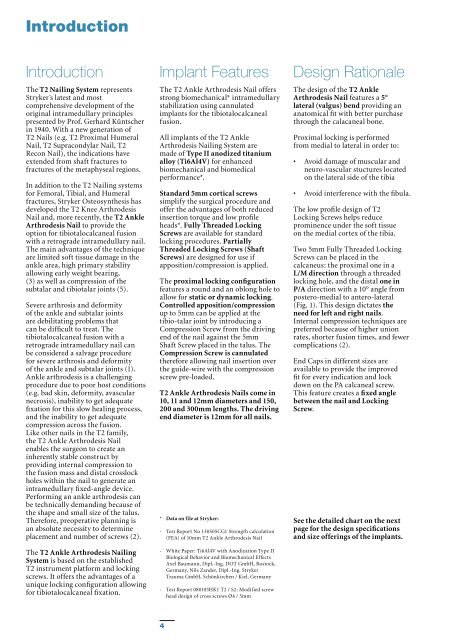T2 Ankle Arthrodesis Nail - Stryker
T2 Ankle Arthrodesis Nail - Stryker
T2 Ankle Arthrodesis Nail - Stryker
Create successful ePaper yourself
Turn your PDF publications into a flip-book with our unique Google optimized e-Paper software.
Introduction<br />
Introduction<br />
The <strong>T2</strong> <strong>Nail</strong>ing System represents<br />
<strong>Stryker</strong>´s latest and most<br />
comprehensive development of the<br />
original intramedullary principles<br />
presented by Prof. Gerhard Küntscher<br />
in 1940. With a new generation of<br />
<strong>T2</strong> <strong>Nail</strong>s (e.g. <strong>T2</strong> Proximal Humeral<br />
<strong>Nail</strong>, <strong>T2</strong> Supracondylar <strong>Nail</strong>, <strong>T2</strong><br />
Recon <strong>Nail</strong>), the indications have<br />
extended from shaft fractures to<br />
fractures of the metaphyseal regions.<br />
In addition to the <strong>T2</strong> <strong>Nail</strong>ing systems<br />
for Femoral, Tibial, and Humeral<br />
fractures, <strong>Stryker</strong> Osteosynthesis has<br />
developed the <strong>T2</strong> Knee <strong>Arthrodesis</strong><br />
<strong>Nail</strong> and, more recently, the <strong>T2</strong> <strong>Ankle</strong><br />
<strong>Arthrodesis</strong> <strong>Nail</strong> to provide the<br />
option for tibiotalocalcaneal fusion<br />
with a retrograde intramedullary nail.<br />
The main advantages of the technique<br />
are limited soft tissue damage in the<br />
ankle area, high primary stability<br />
allowing early weight bearing,<br />
(3) as well as compression of the<br />
subtalar and tibiotalar joints (5).<br />
Severe arthrosis and deformity<br />
of the ankle and subtalar joints<br />
are debilitating problems that<br />
can be difficult to treat. The<br />
tibiotalocalcaneal fusion with a<br />
retrograde intramedullary nail can<br />
be considered a salvage procedure<br />
for severe arthrosis and deformity<br />
of the ankle and subtalar joints (1).<br />
<strong>Ankle</strong> arthrodesis is a challenging<br />
procedure due to poor host conditions<br />
(e.g. bad skin, deformity, avascular<br />
necrosis), inability to get adequate<br />
fixation for this slow healing process,<br />
and the inability to get adequate<br />
compression across the fusion.<br />
Like other nails in the <strong>T2</strong> family,<br />
the <strong>T2</strong> <strong>Ankle</strong> <strong>Arthrodesis</strong> <strong>Nail</strong><br />
enables the surgeon to create an<br />
inherently stable construct by<br />
providing internal compression to<br />
the fusion mass and distal crosslock<br />
holes within the nail to generate an<br />
intramedullary fixed-angle device.<br />
Performing an ankle arthrodesis can<br />
be technically demanding because of<br />
the shape and small size of the talus.<br />
Therefore, preoperative planning is<br />
an absolute necessity to determine<br />
placement and number of screws (2).<br />
The <strong>T2</strong> <strong>Ankle</strong> <strong>Arthrodesis</strong> <strong>Nail</strong>ing<br />
System is based on the established<br />
<strong>T2</strong> instrument platform and locking<br />
screws. It offers the advantages of a<br />
unique locking configuration allowing<br />
for tibiotalocalcaneal fixation.<br />
Implant Features<br />
The <strong>T2</strong> <strong>Ankle</strong> <strong>Arthrodesis</strong> <strong>Nail</strong> offers<br />
strong biomechanical* intramedullary<br />
stabilization using cannulated<br />
implants for the tibiotalocalcaneal<br />
fusion.<br />
All implants of the <strong>T2</strong> <strong>Ankle</strong><br />
<strong>Arthrodesis</strong> <strong>Nail</strong>ing System are<br />
made of Type II anodized titanium<br />
alloy (Ti6Al4V) for enhanced<br />
biomechanical and biomedical<br />
performance*.<br />
Standard 5mm cortical screws<br />
simplify the surgical procedure and<br />
offer the advantages of both reduced<br />
insertion torque and low profile<br />
heads*. Fully Threaded Locking<br />
Screws are available for standard<br />
locking procedures. Partially<br />
Threaded Locking Screws (Shaft<br />
Screws) are designed for use if<br />
apposition/compression is applied.<br />
The proximal locking configuration<br />
features a round and an oblong hole to<br />
allow for static or dynamic locking.<br />
Controlled apposition/compression<br />
up to 5mm can be applied at the<br />
tibio-talar joint by introducing a<br />
Compression Screw from the driving<br />
end of the nail against the 5mm<br />
Shaft Screw placed in the talus. The<br />
Compression Screw is cannulated<br />
therefore allowing nail insertion over<br />
the guide-wire with the compression<br />
screw pre-loaded.<br />
<strong>T2</strong> <strong>Ankle</strong> <strong>Arthrodesis</strong> <strong>Nail</strong>s come in<br />
10, 11 and 12mm diameters and 150,<br />
200 and 300mm lengths. The driving<br />
end diameter is 12mm for all nails.<br />
* Data on file at <strong>Stryker</strong>:<br />
- Test Report No 130505CG1 Strength calculation<br />
(FEA) of 10mm <strong>T2</strong> <strong>Ankle</strong> <strong>Arthrodesis</strong> <strong>Nail</strong><br />
- White Paper: Ti6Al4V with Anodization Type II<br />
Biological Behavior and Biomechanical Effects<br />
Axel Baumann, Dipl.-Ing. DOT GmbH, Rostock,<br />
Germany, Nils Zander, Dipl.-Ing. <strong>Stryker</strong><br />
Trauma GmbH, Schönkirchen / Kiel, Germany<br />
- Test Report 080103HK1 <strong>T2</strong> / S2: Modified screw<br />
head design of cross screws Ø4 / 5mm<br />
Design Rationale<br />
The design of the <strong>T2</strong> <strong>Ankle</strong><br />
<strong>Arthrodesis</strong> <strong>Nail</strong> features a 5°<br />
lateral (valgus) bend providing an<br />
anatomical fit with better purchase<br />
through the calacaneal bone.<br />
Proximal locking is performed<br />
from medial to lateral in order to:<br />
• Avoid damage of muscular and<br />
neuro-vascular stuctures located<br />
on the lateral side of the tibia<br />
• Avoid interference with the fibula.<br />
The low profile design of <strong>T2</strong><br />
Locking Screws helps reduce<br />
prominence under the soft tissue<br />
on the medial cortex of the tibia.<br />
Two 5mm Fully Threaded Locking<br />
Screws can be placed in the<br />
calcaneus: the proximal one in a<br />
L/M direction through a threaded<br />
locking hole, and the distal one in<br />
P/A direction with a 10° angle from<br />
postero-medial to antero-lateral<br />
(Fig. 1). This design dictates the<br />
need for left and right nails.<br />
Internal compression techniques are<br />
preferred because of higher union<br />
rates, shorter fusion times, and fewer<br />
complications (2).<br />
End Caps in different sizes are<br />
available to provide the improved<br />
fit for every indication and lock<br />
down on the PA calcaneal screw.<br />
This feature creates a fixed angle<br />
between the nail and Locking<br />
Screw.<br />
See the detailed chart on the next<br />
page for the design specifications<br />
and size offerings of the implants.<br />
4
















